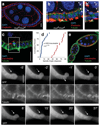Lateral adhesion drives reintegration of misplaced cells into epithelial monolayers
- PMID: 26414404
- PMCID: PMC4878657
- DOI: 10.1038/ncb3248
Lateral adhesion drives reintegration of misplaced cells into epithelial monolayers
Abstract
Cells in simple epithelia orient their mitotic spindles in the plane of the epithelium so that both daughter cells are born within the epithelial sheet. This is assumed to be important to maintain epithelial integrity and prevent hyperplasia, because misaligned divisions give rise to cells outside the epithelium. Here we test this assumption in three types of Drosophila epithelium; the cuboidal follicle epithelium, the columnar early embryonic ectoderm, and the pseudostratified neuroepithelium. Ectopic expression of Inscuteable in these tissues reorients mitotic spindles, resulting in one daughter cell being born outside the epithelial layer. Live imaging reveals that these misplaced cells reintegrate into the tissue. Reducing the levels of the lateral homophilic adhesion molecules Neuroglian or Fasciclin 2 disrupts reintegration, giving rise to extra-epithelial cells, whereas disruption of adherens junctions has no effect. Thus, the reinsertion of misplaced cells seems to be driven by lateral adhesion, which pulls cells born outside the epithelial layer back into it. Our findings reveal a robust mechanism that protects epithelia against the consequences of misoriented divisions.
Conflict of interest statement
The authors declare no competing financial interests.
Figures





References
-
- Pease JC, Tirnauer JS. Mitotic spindle misorientation in cancer--out of alignment and into the fire. J Cell Sci. 2011;124:1007–1016. - PubMed
-
- McCaffrey LM, Macara IG. Epithelial organization, cell polarity and tumorigenesis. Trends Cell Biol. 2011;21:727–735. - PubMed
-
- Fernández-Miñán A, Martín-Bermudo MD, González-Reyes A. Integrin signaling regulates spindle orientation in Drosophila to preserve the follicular-epithelium monolayer. Curr Biol. 2007;17:683–688. - PubMed
-
- Kraut R, Chia W, Jan LY, Jan YN, Knoblich JA. Role of inscuteable in orienting asymmetric cell divisions in Drosophila. Nature. 1996;383:50–55. - PubMed
Publication types
MeSH terms
Substances
Grants and funding
LinkOut - more resources
Full Text Sources
Other Literature Sources
Molecular Biology Databases

